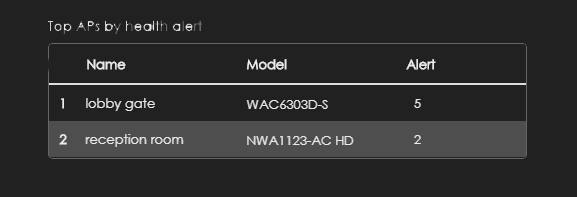
- Home
- Nebula Professional Features & Spotlights
- Groundbreaking wireless health monitor detects and fixes wireless network problems
Groundbreaking wireless health monitor detects and fixes wireless network problems
Groundbreaking wireless health monitor detects and fixes wireless network problems
Knowing your wireless network performance may be good enough. Nebula wireless health goes above and beyond than competitive offerings to simplify root cause analysis of the connected AP devices, enabling IT team to simply monitor, detect, and fix connection issues in a single pane of glass.
What went wrong with your wireless network connection?
After adopting the latest 802.11ac Wave 2 solution, deploying more access points, and even upgrading the network infrastructure, you have done pretty much everything in your power to improve the WiFi performance; however, with the ever-growing demands for WiFi connection, it seems that you just can't simply keep your WiFi users happy. There are many reasons that can affect wireless network performance, but unfortunately IT administrators often lack of a useful tool to detect and fix connection problems and optimize network performance automatically.
Why does a wireless network fail?
As the network complexity increases, the potential for degraded performance looms larger. To ensure a seamless wireless connection, there are countless factors IT administrators need to pay attention to. Here are three typical factors in real-world practice that even top-gear WiFi AP vendor can’t guarantee to fix all these problems:
- Interference: This is a severe problem that can significantly obstruct the wireless network performance. Besides the interference from access point itself, other wireless applications can also introduce co-channel and adjacent interference. And as the popularity of 4G/5G technology increases, indoor antennas are commonly seen in public venues. Although 4G/5G operates in a different band than WiFi, it still introduces interference, which also known as out-of-band interference.
- Congested environments: The biggest challenge in high density venues is interference and overload due to a large number of clients contesting for limited bandwidth.
- Abnormal connections: Sometimes, the problem is from the client device. It could be misconfigured or sticking to a remote access point. Those problematic wireless clients with weak transmitting capability will continually lose packages and keep retrying that occupy air time but never complete the transmissions.
Nebula Wireless Health
However, it is not easy to evaluate the level of impact of the above factors has on the wireless performance. The result may not be useful for improving WiFi performance because simply there are too many variables to consider in each factor. Nebula wireless health overcomes this challenge by using the MAC-layer-based analysis since it not only covers all the impacting factors by processing packet loss or retransmission on the MAC layer in its analysis, but also eliminates the need for additional sensors, making it an ideal choice for accurate wireless health analysis.

Nebula Wireless Health is a powerful analytic system that constantly monitors and optimizes the connection quality. Its report provides IT administrators with an overview of the AP’s health condition and the client’s perspective. Moreover, the system takes a step further to provide a total solution that not only diagnoses the health of wireless networks but also offers automatic optimization actions to improve network performance and user experience.
AP condition monitoring and report
Wireless health starts with showing the number of the APs currently connected by radio. The connection quality of the access points is ranked as Good, Fair or Poor by a performance evaluation system.
- Good: APs running in a good performance.
- Fair: Require supervision on those APs as they may encounter temporary interference or a short peak loading, but the situation doesn't really impact user experience.
- Poor: Performance is impacted by certain factors and user may experience latency if they are using the time-sensitive stream. Administrators should take action on those APs.

The dot chart below shows the history of AP status based on the set time frame. Here, you can have a glance view of the wireless network condition and the table of Top APs by health alert sorts out how many times the alert have been issued by the AP based on the set time frame.


Respond to those alerts automatically
Nebula wireless health provides automatic optimization actions to accelerate troubleshooting. IT administrators only need to turn on the function, then NCC will automatically execute the remedy action when it identifies a connection problem experiencing by any access point.
Client condition monitoring and report
The concept of client section is similar to above. First, you can have a quick view of current client status. Next, following up with the history of client wireless health status on the set time frame, up to 30 days. Then, it comes the table of Top clients by health alert. Based on the analysis, IT administrators can take action by contacting their guest or colleague with poor wireless performance and help them fix the misconfigurations or other client connection issues. Also, Nebula wireless health offers the function of Clients auto optimization that will steer poor performing client to connect with a neighboring AP.

Summary
Nebula wireless health goes above and beyond competitive offerings, which typically do little more than summarize AP performance. Nebula works behind the scene to actually resolve the underlying problems. The AP and client status illustrations provide an overview for IT administrators to understand the condition of the wireless network and the auto optimization feature helps you solve the connection issues without actually being onsite for troubleshooting, which will certainly help businesses save more time and money.



